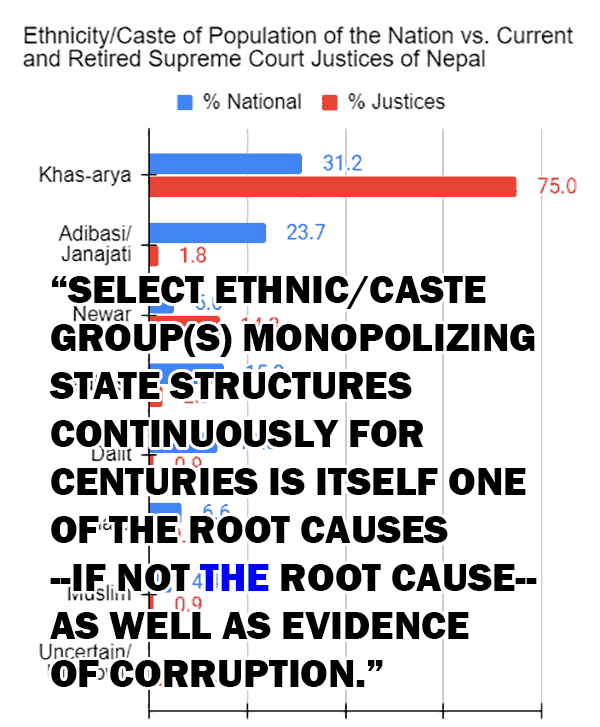
According to former-General Attorney Raman Kumar Shrestha only 11% of the population of the country have ACCESS to justice mechanism. Former IGP Bigyan Raj Sharma estimates that 30% of those incarcerated in jails around the country are innocent. What percent of those found guilty by the criminal justice system are free? Who knows but my own guess? Likely a significantly high percent.
The Global Corruption Report 2007 had declared the Judiciary to be “one of the most corrupt sectors in the country.” The scandal around Chief Justice Cholendra Shumsher Rana, which surfaced in Oct. 2021, exposed, yet again, how the corruption in the judiciary led to that. The body had been racked with scandals and irregularities all the while as per The Kathmandu Post article.
One of the biggest recent scandals, before the Chief Justice himself came under scrutiny, was the audio recording of a Judge and a lawyer of a high profile client discussing kick-backs for favorable ruling: bail for the client. The article reports, and I quote:
“Former Supreme Court justices say the audio clip that has surfaced is just the tip of the iceberg and that corruption is deep-rooted in Nepal’s judiciary.”
It might NOT be a stretch to state that, all the institutions of our legal system as a whole are corrupt to the core. Why? The judiciary has been and continues to be monopolized by the hill so-called high caste Hindu and Newar men, one of the many consequences of the caste-based social structure of the country.
While the caste system had been an informal basis in India’s and Nepal’s social structures for centuries, in the latter, it was codified in the 1854 Muluki Ain (The Law of the Land, i.e. The Constitution) and received legal sanction. According to it, the people of the country belong to one of five castes (see below) with the so-called high caste Hindus — made up of Bahuns/Brahmins and Chettris, also referred to together as Khas-arya — at the top.
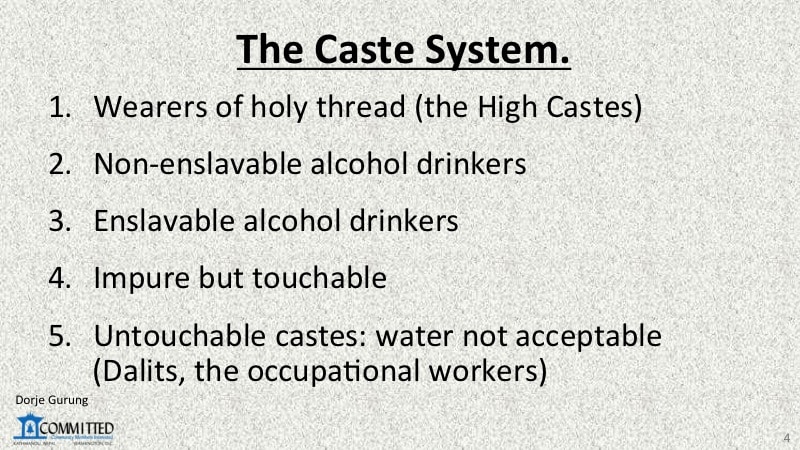
While, in doing so, the highly casteist constitution essentially provided legal support and protection for the social system’s informal recognition of caste-based birth occupations, that wasn’t even the worst. The most outrageous provision was differential punishments for the same crime based on the caste of the perpetrator — the lower the caste the harsher the punishment. For instance, while capital punishment was allowed, the State was forbidden from issuing it to the Bahuns/Brahmins, the highest caste.
How did that happen or how was that even allowed? One reason? All but seven of the 230 signatories to the 1854 constitution, as you can see in the bar chart below, was a hill so-called high caste Hindu. The remaining seven were Newars, those belonging to the next caste down, namely the “Non-enslavable alcohol drinker.” That is, they were monopolized by the trio of Bahun-Chettri-Newar (BCN) groups.
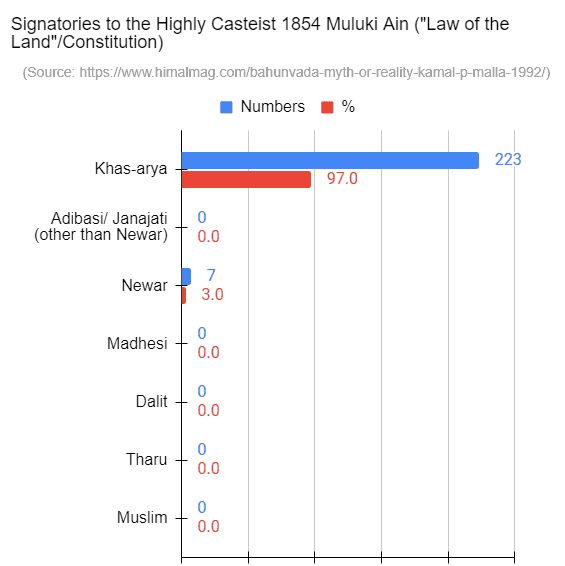
The casteist Muluk Ain was amended only in 1963, more than a century later, but by then the damage had already been done. Many of the social, economic, political issues arising from their structures that the country suffers from even now, in the twenty-first century, are mostly a legacy of that. One of those structures — surprise, surprise — is our judiciary.
But before that, a point about the “Unknown/Uncertain” category appearing in the charts from hereon. Surnames whose caste or category could not be determined using my sources were thrown into the “unknown” category. As for “Uncertain,” these were surnames common to two or more ethnic groups, such as सिंह (Singh) who could be a Newar, Khas-arya, or a Tharu; Joshi who could be a Khas-Arya or a Newar; चौधरी (Chaudary/Chaudari) who could be a Tharu or a Madhesi etc.
Let’s start by looking at the Supreme Court Justices. First a breakdown of the Chief Justices.
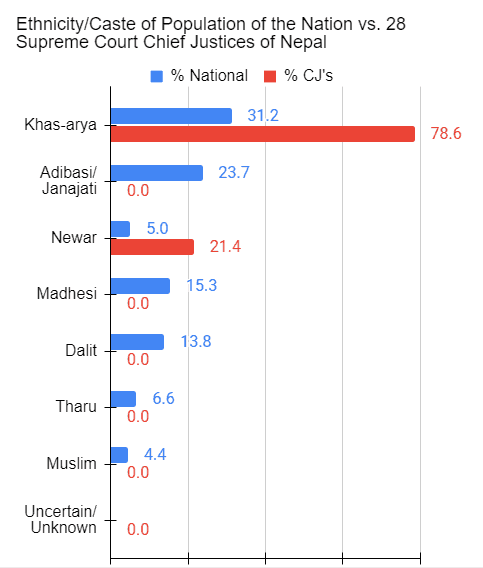
The composition is no different from that of the signatories to the 1854 Muluki Ain — ONLY BCN’s. The only difference is in the percentages. At over 78%, the hill so-called high castes are represented more than twice their proportion in the population. The Newars, at over 21%, are represented more than four times their proportion in the population. The rest of the population, representing almost 65%, have no representation at all.
Here’s a breakdown of the current Supreme Court justices.
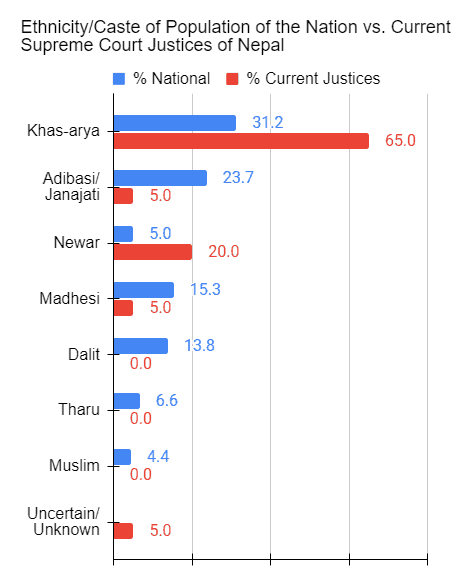
While both the Khas-aryas and Newars have disproportionately high representation — more than twice and four times their proportion in the population respectively — Janajatis and Madhesis have a small representation (5% each), much smaller than their proportion in the population. Dalits, Tharus, and Muslims have NO representation.
What about representation in the past, since the promulgation of Muluki Ain? Here’s a break down of the retired Supreme Court justices.
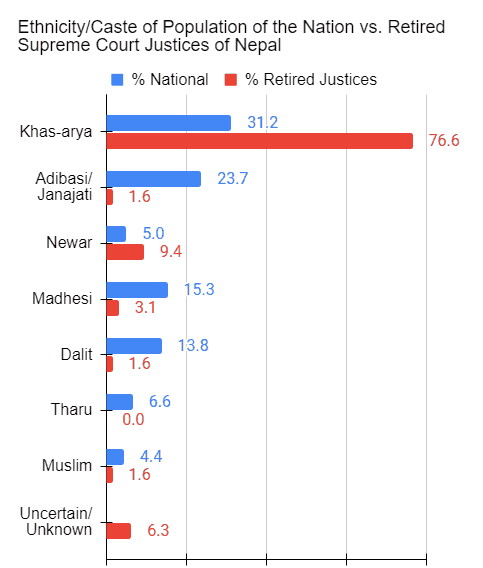
They have had BUT insignificantly small representation, forget proportional! The Tharus have had none.
What about the breakdown by gender? See chart below.
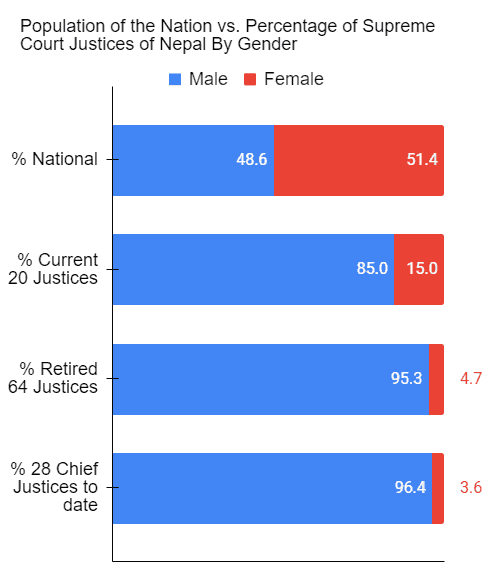
The 15% of the current justices is actually just three out of twenty. As for the retired justices, 4.7% also happens to be just three (out of sixty-four). As for the Chief Justices, we have had a grand total of one — ONE — female Chief Justice.
How do the seven female justices breakdown by ethnicity/caste etc.?
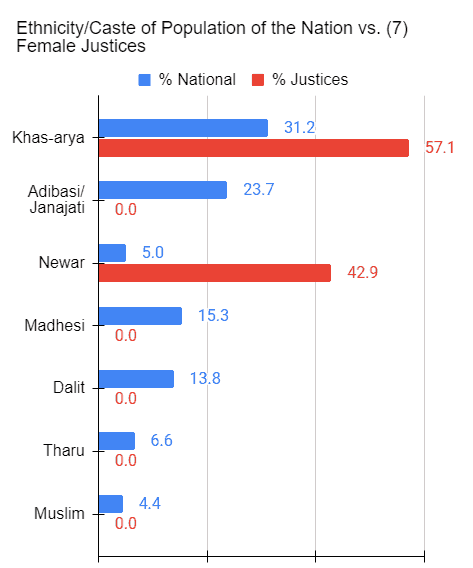
Every single one of the seven females represent just BCNs, no different from the make-up of the Muluki Ain signatories — of about 170 years ago, sadly!
Moving on to the next fraternity that makes up the legal system, members of the Nepal Bar Association…let’s start with their Presidents since 1956.
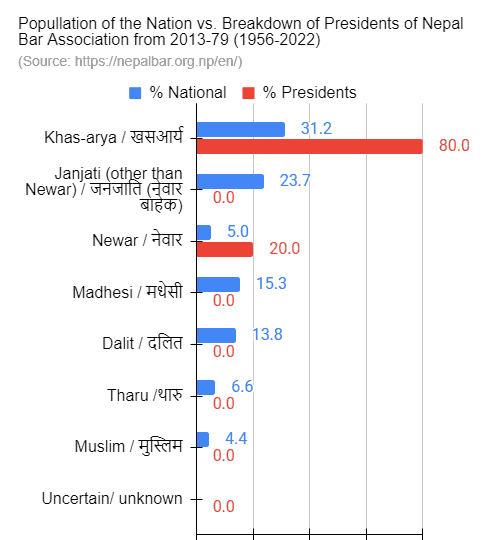
As you can see, it’s no different from the breakdown of the Supreme Court Chief Justices: only BCNs are represented.
Here’s a breakdown of the current Executive Committee Members.
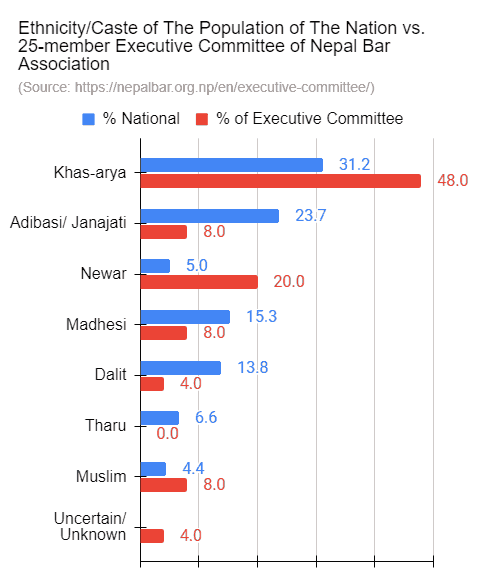
Slightly better than the Supreme Court Justices but still nowhere near what it should be. BCNs are, again, disproportionately highly represented. There is also a surprise here with Muslims also being disproportionately highly represented. The rest are represented but nowhere near their proportion in the population.
How was it in the past? Here’s how the members of the Executive Committees between 1956-1991 and 1991-2022 breakdown. (I chose to lump them into these two groups since, in 1990, we transitioned into a democratic form of governance from an autocratic King.)
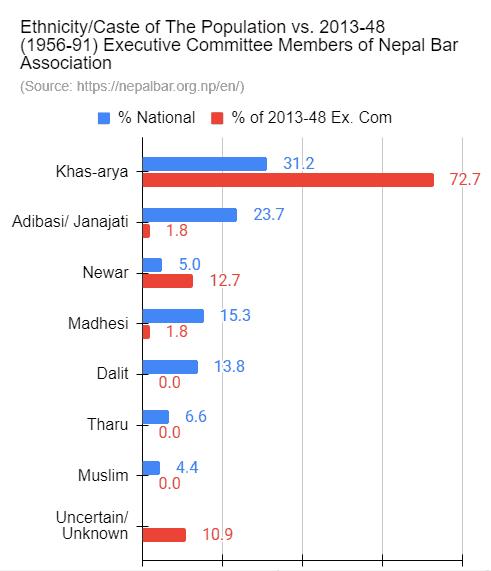
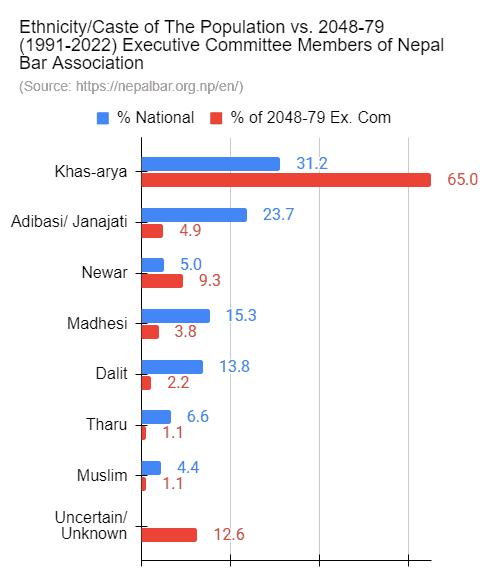
Some might argue that there’s been improvements going from autocratic Kingdom to a democracy but to me it’s nothing to rave about. Sure Dalits, Tharus, and Muslims have representation during democracy from the previous zero representation BUT the essential monopoly of the BCNs is still intact. I would be surprised if the double-digit percent of those relegated to the “unknown/uncertain” do NOT consist mostly of BCNs too!
How do the Executive Committee Members of the Nepal Bar Association breakdown by gender? It’s NOT pretty.
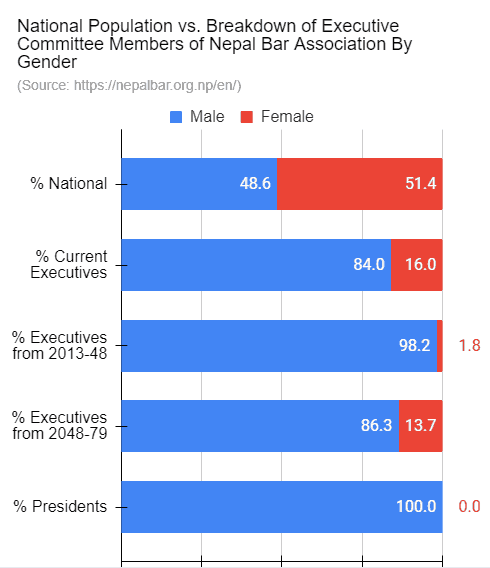
Sure, there’s been an increase from 1.8% (2 out of 110) during the rule of the autocrats to 13.7% (25 out of 183) during democracy. And in the current executive team it’s 16% (4 out of 25)! But sadly, at this rate, Kathmandu Valley will likely be uninhabitable before we get anywhere close to proportional representation. That’s what I think anyway.
How do the female lawyers breakdown by ethnicity/caste? Of the two during the autocratic regime, one was a Bahun (a hill so-called high caste Hindu) and the other of “uncertain” caste.
The chart below breaks down the 25 females represented in the Executive Committee from 1991-2022.
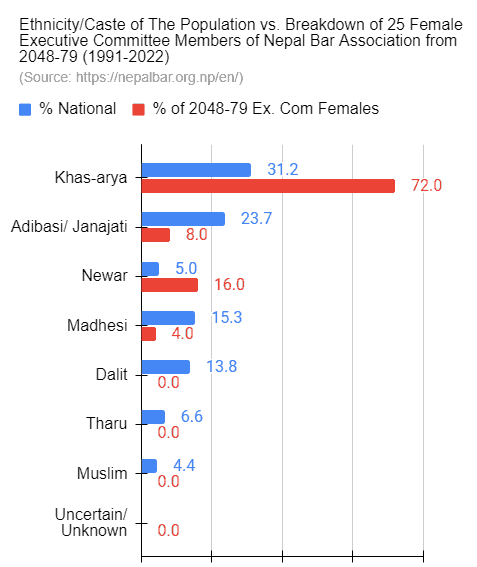
The monopoly of the BCNs are, once again, evident here. They are disproportionately highly represented.
So, to begin with, how is it that the structures have always been so warped? They are deliberately so. The Record in Caste Apartheid in the Judiciary has the details of one 2016 incident which reveals how. Here’s the relevant extract.
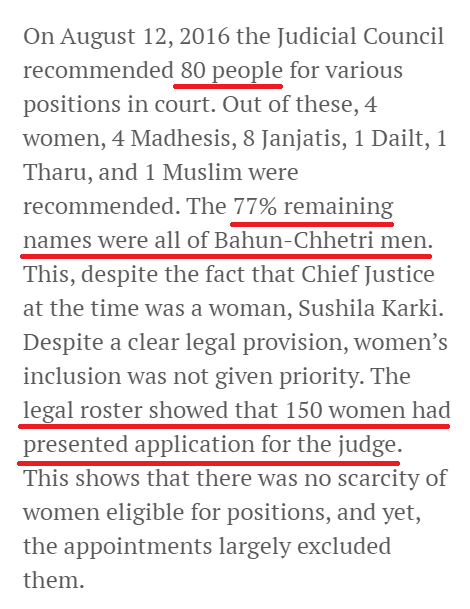
Given that the deliberate exclusion of females occurred in 2016, what are the chances that was NOT happening, firstly, prior to that and, secondly, with candidates belonging to other ethnicity or caste or other groups?! Surely, that could be one of the explanations behind the disproportionately high representation of the BCNs?!
Are you then surprised that the legal system is so corrupt?! I would have been surprised if it WEREN’T! That is, that the BCN men have monopolized the legal system is one of the root causes — if not THE root cause — as well as evidence of corruption. How else would they have been able to stack the structure to that extent and for that length of time without employing corrupt practices itself, like the one referenced above?!
The structure of the legal system is not alone in its stark lack of representation from most of the rest of the population. It is supported by the equally monopolized legislature, the executive — as represented by those who have held the Prime Minister’s post — and the media.
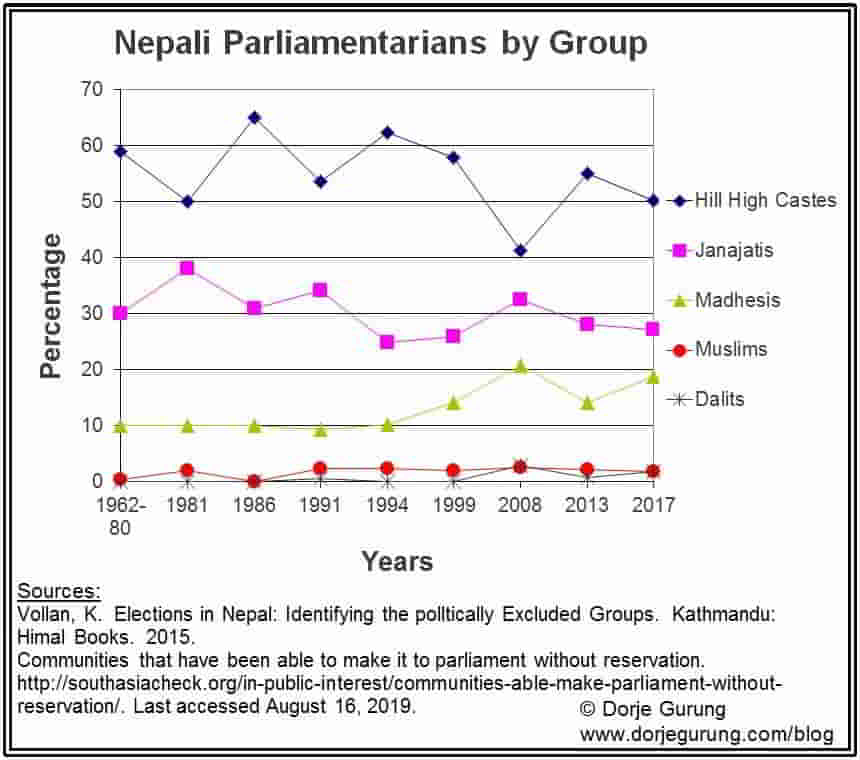
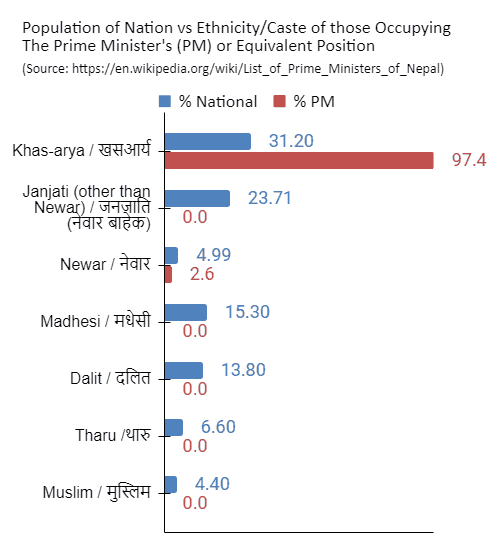
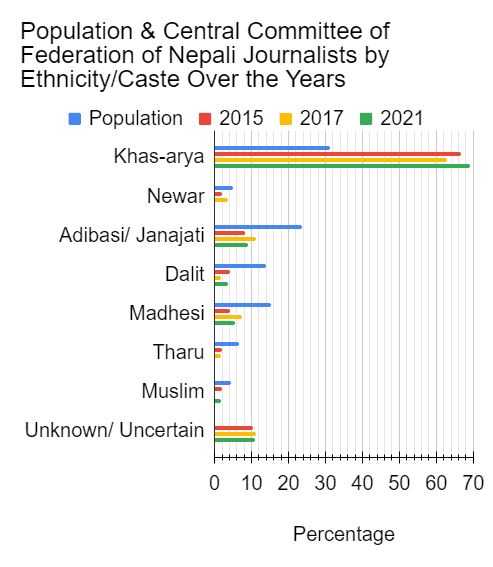
If that’s not enough, the police and the army are no different either.
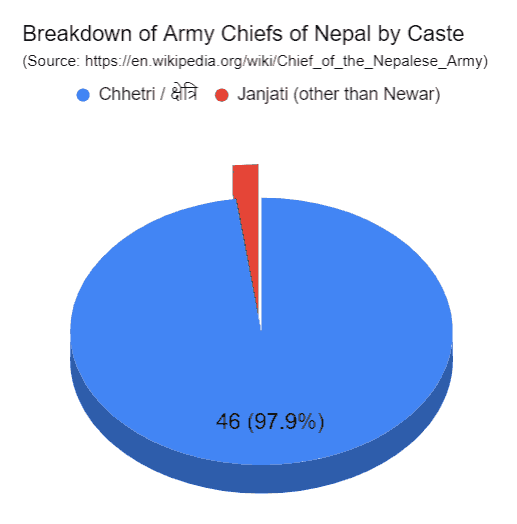
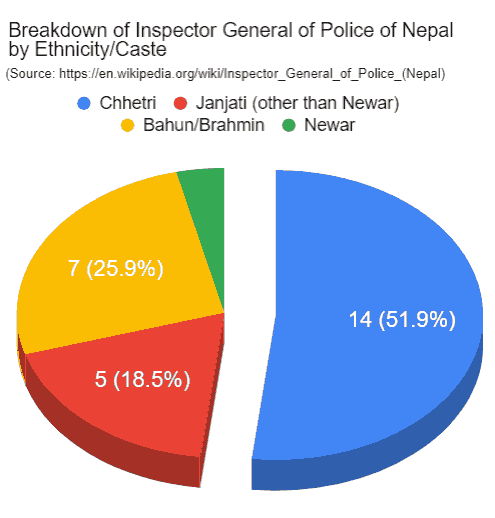
In other words, these bodies are a reflection and outcome of the corrupt systems, mentality, and culture — mainly hill so-called high caste Hindu male culture — that produce, prop up, and perpetuate them. The hill so-called high caste Hindu males are highly tribal, among other things, view themselves as superior to others — obviously, just look at the caste system — and likely also believe that they are the most capable and that they are even entitled to those positions.
Is it any wonder then that the disproportionate representation has promoted corruption in the legal system as has been shown to be the case again and again, most recently highlighted by the accusation labeled against the current Chief Justice Rana, a hill so-called high caste Hindu man?! He was impeached! The farce that started last Fall, almost a year ago, climaxed a day ago!
Interestingly enough, while this time there’s been a kind of a revolt from the legal fraternity against the Chief Justice, in an incident of 2018 they were, not surprisingly, highly tribal. The incident also involved the Chief Justice at the time.
The then-Chief went after an individual pursuing some personal vendetta and also after the media abusing his position. But most — if not all — in the fraternity were conspicuously silent. The Kathmandu Post article reported on the intriguing discovery it had made as to the reason. With every single one of them, the reason for not speaking up against the Chief Justice overstepping his bounds was the same outrageous one: “Why antagonize friends and family?!” In other words, they were all looking out for each other!
Having said that, I am NOT arguing that the legal system is corrupt BECAUSE BCNs are corrupt and people belonging to other ethnic or social groups are NOT. To reiterate, any structure monopolized by any ethnic or social group or some small combination of ethnic groups, regardless of their identities, would be corrupt had they done so to the extent and for the length of time as the BCNs have the judiciary.
So finally, is it any wonder that such a small percent of the population have access to justice mechanism and there’s such a high level of miscarriage of justice making the criminal justice system itself, in my opinion, criminal in Nepal?!
What do you think?

